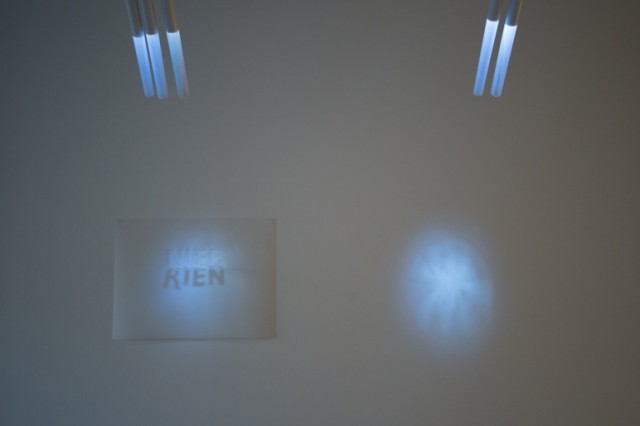An encounter with the French Symbolist poet Mallarmé in Paris1 prompted Montreal artist Karen Trask‘s artistic explorations of the concept and philosophical question of rien, or nothing, the results of which now inhabit the Centre d’exposition Circa. Is it really about nothing? Yes and no: the artist has remarked that the desire to embody a presence of “absence” is the impetus behind much of her work. To be sure, what is proposed here is far from nihilism; on the contrary, the ascetic and formally sparse exhibition left me with a paradoxical feeling of plenitude.
The show, which includes video, installation, objects hung on the wall, and text–sometimes scrawled into space with filamentous wire–can be described as multimedia; however, there is nothing of the polyphony that the term can sometimes imply. Most works are derived from, depict, or simulate paper, which is Trask’s primary sculptural material. The objects are subtle: diminutive and mostly white. All exist to pose the same philosophical question which could be phrased as, “what is nothing?” Each asks it slightly differently, according to its material specificity, and all ask it quietly: indeed it is in the closer encounters with them, one at a time, that their particular intensities are felt: humourous, rhetorical, poetic, surprising.
A video screen greets you at the entrance of the gallery, depicting a shadow of a hand, grasping at a falling piece of paper, often missing it; the repetition of this play of intangibility gives it its shape and sensibility. The large hanging scrim in the centre of the gallery is a fused swath of handmade paper, strengthened with linen fibres, and interlaced with fibre optics: small constellations of light pulse on and off in random sequence. Talking with the artist before this work, we were lucky to glimpse one of the more sporadic ones, like a shooting star that glances off your peripheral vision. There were many such moments in this show–quiet surprises that felt like a reward or affirmation for having come and given them your attention.
While all works here are essentially “time-based,” in that they require a bit of your time to show themselves to you, two small works deployed the mechanical time of clocks in ways that I found especially funny, a little absurd, and extremely pleasing. This effect, I feel, is directly related to the time you spend with the piece, as you are compelled to wait until the clock hands’ specific configuration reveals their secret, which I won’t spoil for you.
The vast, cool-white space of the gallery gives Riens a space to inhabit, but it goes the other way too: each object speaks of the space surrounding it. As art and art history has sought to reveal over the past half-century or more–Yves Klein’s 1957 empty exhibition, Le vide, is often cited as the first such attempt–the white gallery is not simply empty. Likewise, each “rien” that constitutes this exhibition, by existing in its own place and calling itself “nothing,” has already given absence a shape. Collectively, they make a congregation of nothings, which is even more undeniably something.
Indeed, the compounding of “nothing” implied by the title consolidates this semantic rupture. This concept is central to Trask’s creative process, which, as she has explained, “has developed as a series of poetic investigations exploring human experience through language. It is the ephemeral and transitory nature of words and language which interests me specifically.”2 What makes this work so interesting is the different registers upon which “rien” is both proposed and negated. Words are both suggestive and fragile; materials, light and space trade places. And by simply walking into Riens we engage in the rich philosophical, literary and artistic history of “nothing.”3
The show, which opened October 20, runs until November 17. If you come on Saturday afternoon you might see the artist there, who is happy to discuss her work with you. I really liked this show and encourage you to see for yourself how interesting nothing can be.
Centre d’exposition Circa, space 444
Karen Trask
Riens
October 20 – November 17, 2012
www.circa-art.com
1 As more than a century separates us from Mallarme, I am assuming Trask made his acquaintance through his literature.
3 Trask has also created a beautiful book to accompany the exhibition.



